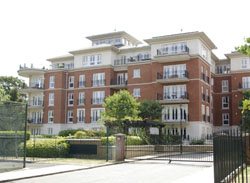Richmond Ice Rink
From leisure centre to luxury apartments in Twickenham
1924-1992

Meanwhile, ice-skating rinks were prospering in other parts of London, notably in Hammersmith and Earls Court. Claude Langdon was the man behind the Hammersmith rink and he conceived what might be described as the country's first leisure centre - a sports hall, ice rink, tennis courts, a bowling green and restaurants - on the Clevedon Road site. The rink and the site were now for sale and the excellent transport links with other parts of London made it an obvious choice. In the early 1920s, Langdon raised the necessary money and bought the site.
Construction of this huge project took from 1924 to 1927. The old rink was demolished and replaced by a new 285ft long rink, with a concrete barrel roof supported by concrete pillars and balconies. The rink was edged in mahogany and state-of-the-art ice making machines were installed. When the rink opened in 1928, the Hammersmith rink became the Palais and its skaters were given free tickets for the new Richmond rink. All the clubs that had been based at Hammersmith and Earls Court transferred to Richmond, making it the premier rink in London. Despite this initial success, financial difficulties caused the rink to close for a short time in 1930, reopening with new owners: Major Hubert Martineau, The Rule Family and the Gerschwilers.

In 1934, a stand of seats at the South end of the rink was removed and replaced by a seawater pool. Water was brought from Sussex every week and the excess heat from the ice-making equipment warmed the pool. The initiative was not entirely successful - the water was prone to algae formation - and after a year the rink was roofed over to form a new small ice-rink. This was named the Arosa rink reputedly after Arnold Gerschwiler's (see below) Swiss birthplace, though he was actually born in Arbon. Skaters were probably unaware that they were skating over a 9ft void.
In 1939, at the outbreak of the Second World War, all theatres, halls and ice rinks were ordered to close. However, many American servicemen had skated and played ice hockey regularly at Richmond, so the US Embassy persuaded the government to allow it to re-open, albeit with blacked-out windows. In 1940, a 2000lb bomb fell onto the ice and slid into the machinery room. It failed to explode, and it was removed to Hounslow Heath and exploded. The rink re-opened the next day.
Arnold Gerschwiler, OBE (1914 to 2003)
Arnold Gerschwiler was born in Switzerland in 1914. Encouraged by his brother, who was already an ice-skating instructor, he came to England. He competed in the British Open Championships in 1935 and 1936 and then became an instructor at Richmond in 1937. He became head coach a year later, running the tuition with Swiss precision, and taught until his retirement when the rink closed in 1992, interrupted only when the Swiss army called him up for a year in 1939. Among the many professional skaters who benefited from his tuition were Valda Osborn (1953 European title holder), Aja Vrzanova (world champion in 1949 and 1950), Sjoukje Dijkstra (held Olympic and European titles in the 1960s), John Curry and the British champions Michael Booker and Patricia Dodd. He taught many celebrities including Princess Anne, James Mason and Patricia Roc. The Richmond International Trophy, which ran from 1949 to 1980, was largely Gerschwiler's inspiration as were the children's skating classes, started in 1949. He was made a director of the rink in 1964 and was awarded an OBE in 1997. He and his wife Violet lived in Ailsa Road until his death in August 2003.

Recent history
The rink was sold to a property developer in 1978, who kept it running until 1987, when it was bought by another property company - the London and Edinburgh Trust. The company intended to develop the site for luxury housing. As part of the planning conditions, the company was obliged to locate an alternative site in the borough and construct a new rink on it. In 1989, the council, accepting £2.5M as compensation, withdrew this condition. In 1992, the rink closed, the building was demolished. No replacement rink has been built.




